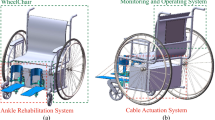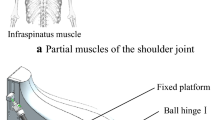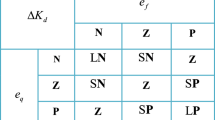Abstract
Since there are external uncertainties in the environment and the dynamic properties of human arm are time-varying during movement, it is difficult to achieve good tracking performance during robot-aided rehabilitation. The purpose of this study is to develop an adaptive controller with a fuzzy tuner for a cable-based rehabilitation robot. The fuzzy tuner can adjust the control parameters according to position error and the change of error, thus the time-varying control parameters can be optimized by this tuner. To verify the proposed controller, simulation and experiment studies using the cable-based rehabilitation robot are carried out. The rehabilitation robot is employed to complete two facilitation movements in the experiment. Results show that the adaptive controller can attain better control performance after tuning the control parameters.
Similar content being viewed by others
References
H. Nakayama, H. Jgtgensen, K. Stig, H. O. Raaschou, and T. S. Olsen, “Recovery of upper extremity function in stroke patients: the Copenhagen Stroke Study,” Age (SD), vol. 74, no. 11, pp. 12, May 1994.
V. Parker, D. Wade, and R. L. Hewer, “Loss of arm function after stroke: measurement, frequency, and recovery,” Disability & Rehabilitation, vol. 8, no. 2, pp. 69–73, February 1986.
N. Hogan, H. I. Krebs, J. Charnnarong, P. Srikrishna, and A. Sharon, “MIT-MANUS: a workstation for manual therapy and training. I.” Proc. of Robot and Human Communication IEEE International Workshop on, pp. 161–165, September 1992.
D. M. Morris, and E. Taub, “Constraint-induced therapy approach to restoring function after neurological injury,” Topics in Stroke Rehabilitation, vol. 8, no. 3, pp. 16–30, February 2001.
M.-K. Chang, “An adaptive self-organizing fuzzy sliding mode controller for a 2-DOF rehabilitation robot actuated by pneumatic muscle actuators,” Control Engineering Practice, vol. 18, no. 1, pp. 13–22, January 2010. [click]
A. Frisoli, C. Loconsole, R. Bartalucci, and M. Bergamasco, “A new bounded jerk on-line trajectory planning for mimicking human movements in robot-aided neurorehabilitation,” Robotics and Autonomous Systems, vol. 61, no. 4, pp. 404–415, April 2013. [click]
J. Patton, G. Dawe, C. Scharver, F. Mussa-Ivaldi, and R. Kenyon, “Robotics and virtual reality: a perfect marriage for motor control research and rehabilitation,” Assistive Technology, vol. 18, no. 2, pp. 181–195, October 2006.
P. S. Lum, C. G. Burgar, P. C. Shor, M. Majmundar, and M. Van der Loos, “Robot-assisted movement training compared with conventional therapy techniques for the rehabilitation of upper-limb motor function after stroke,” Archives of Physical Medicine and Rehabilitation, vol. 83, no. 7, pp. 952–959, July 2002. [click]
S. Masiero, A. Celia, G. Rosati, and M. Armani, “Roboticassisted rehabilitation of the upper limb after acute stroke,” Archives of Physical Medicine and Rehabilitation, vol. 88, no. 2, pp. 142–149, February 2007. [click]
M. Rahman, M. Saad, C. Ochoa-Luna, J. Kenne, and P. Archambault, “Cartesian trajectory tracking of an upper limb exoskeleton robot.” Proc. of IECON 38th Annual Conference on IEEE Industrial Electronics Society, pp. 2668–2673, October 2012. [click]
H. I. Krebs, N. Hogan, M. L. Aisen, and B. T. Volpe, “Robot-aided neurorehabilitation,” Rehabilitation Engineering, IEEE Transactions on, vol. 6, no. 1, pp. 75–87, Marth 1998. [click]
P. S. Lum, C. G. Burgar, and P. C. Shor, “Evidence for improved muscle activation patterns after retraining of reaching movements with the MIME robotic system in subjects with post-stroke hemiparesis,” Neural Systems and Rehabilitation Engineering, IEEE Transactions on, vol. 12, no. 2, pp. 186–194, June 2004. [click]
C. G. Burgar, P. S. Lum, P. C. Shor, and H. M. Van der Loos, “Development of robots for rehabilitation therapy: the Palo Alto VA/Stanford experience,” Journal of rehabilitation research and development, vol. 37, no. 6, pp. 663–674, November 2000.
D. J. Reinkensmeyer, L. E. Kahn, M. Averbuch, A. McKenna-Cole, B. D. Schmit, and W. Z. Rymer, “Understanding and treating arm movement impairment after chronic brain injury: progress with the ARM guide,” Journal of rehabilitation research and development, vol. 37, no. 6, pp. 653–662, November 2000.
G. Rosati, P. Gallina, and S. Masiero, “Design, implementation and clinical tests of a wire-based robot for neurorehabilitation,” IEEE Transactions on Neural Systems and Rehabilitation Engineering, vol. 15, no. 4, pp. 560–569, December 2007. [click]
G. Rosati, P. Gallina, S. Masiero, and A. Rossi, “Design of a new 5 dof wire-based robot for rehabilitation,” Proc. of ICORR 9th International Conference on Rehabilitation Robotics, pp. 430–433, June 2005.
D. Mayhew, B. Bachrach, W. Z. Rymer, and R. F. Beer, “Development of the MACARM-a novel cable robot for upper limb neurorehabilitation,” Proc. of ICORR 9th International Conference on Rehabilitation Robotics, pp. 299–302, June 2005. [click]
E. Ottaviano, G. Castelli, and G. Cannella, “A cable-based system for aiding elderly people in sit-to-stand transfer#,” Mechanics Based Design of Structures and Machines, vol. 36, no. 4, pp. 310–329, November 2008.
P. K. Jamwal, S. Xie, and K. C. Aw, “Kinematic design optimization of a parallel ankle rehabilitation robot using modified genetic algorithm,” Robotics and Autonomous Systems, vol. 57, no. 10, pp. 1018–1027, October 2009. [click]
B. Bouchemal and A. Zaatri, “Image-based control for cable-based robots,” International Journal of Control, Automation and Systems, vol. 12, no. 1, pp. 118–125, February 2014. [click]
H. Mehdi and O. Boubaker, “Stiffness and impedance control using Lyapunov theory for robot-aided rehabilitation,” International Journal of Social Robotics, vol. 4, no. 1, pp. 107–119, November 2012. [click]
S. Hussain, S. Q. Xie, and P. K. Jamwal, “Control of a robotic orthosis for gait rehabilitation,” Robotics and Autonomous Systems, vol. 61, no. 9, pp. 911–919, September 2013. [click]
D. P. Ferris, G. S. Sawicki, and A. R. Domingo, “Powered lower limb orthoses for gait rehabilitation,” Topics in spinal cord injury rehabilitation, vol. 11, no. 2, pp. 34, September 2005.
H. Krebs, B. Volpe, M. Aisen, and N. Hogan, “Increasing productivity and quality of care: robot-aided neurorehabilitation,” Journal of Rehabilitation Research and Development, vol. 37, no. 6, pp. 639–652, November 2000.
B. Volpe, H. Krebs, N. Hogan, L. Edelstein, C. Diels, and M. Aisen, “A novel approach to stroke rehabilitation Robot-aided sensorimotor stimulation,” Neurology, vol. 54, no. 10, pp. 1938–1944, February 2000. [click]
M. L. Aisen, H. I. Krebs, N. Hogan, F. McDowell, and B. T. Volpe, “The effect of robot-assisted therapy and rehabilitative training on motor recovery following stroke,” Archives of Neurology, vol. 54, no. 4, pp. 443–446, April 1997. [click]
K. Kong, “Proxy-based impedance control of a cabledriven assistive system,” Mechatronics, vol. 23, no. 1, pp. 147–153, February 2013.
C. Yang, G. Ganesh, S. Haddadin, S. Parusel, A. Albu-Schaeffer, and E. Burdet, “Human-like adaptation of force and impedance in stable and unstable interactions,” IEEE Transactions on Robotics, vol. 27, no. 5, pp. 918–930, October 2011. [click]
C. Yang, Z. Li, R. Cui, and B. Xu, “Neural network-based motion control of an underactuated wheeled inverted pendulum model,” vol. 25, no. 11, pp. 2004–2016, Novermber 2014.
S. Q. Xie and P. K. Jamwal, “An iterative fuzzy controller for pneumatic muscle driven rehabilitation robot,” Expert Systems with Applications, vol. 38, no. 7, pp. 8128–8137, July 2011. [click]
M.-S. Ju, C.-C. Lin, D.-H. Lin, I.-S. Hwang, and S.-M. Chen, “A rehabilitation robot with force-position hybrid fuzzy controller: hybrid fuzzy control of rehabilitation robot,” IEEE Transactions on Neural Systems and Rehabilitation Engineering, vol. 13, no. 3, pp. 349–358, September 2005. [click]
C. Yoo, S. Ryu, B. Park, Y. Kang, and S. Jung, “Actuator controller based on fuzzy sliding mode control of tilt rotor unmanned aerial vehicle,” International Journal of Control Automation & Systems, vol. 12, no. 6, pp. 1257–1265, December 2014. [click]
Q. H. Ngo, N. P. Nguyen, C. N. Nguyen, T. H. Tran, and K. Hong, “Fuzzy sliding mode control of container cranes,” International Journal of Control Automation & Systems, vol. 13, no. 2, pp. 419–25, April 2015.
Y. Peng, X. Luo, and W. Wei, “A new fuzzy adaptive simulated annealing genetic algorithm and its convergence analysis and convergence rate estimation,” International Journal of Control Automation & Systems, vol. 12, no. 3, pp. 670–679, May 2014.
Z. Li, C. Su, G. Li, and H. Su, “Fuzzy approximation-based adaptive backstepping control of an exoskeleton for human upper limbs,” IEEE Transactions on Fuzzy Systems, vol. PP, no. 99, pp. 1–1, April 2014.
H. Zhang, M. Li, J. Yang, and D. Yang, “Fuzzy modelbased robust networked control for a class of nonlinear systems,” IEEE Transactions on Systems Man & Cybernetics Part A Systems & Humans, vol. 39, no. 2, pp. 437–447, March 2009. [click]
H. Zhang, J. Yang, and C. Su, “T-S fuzzy-model-based robust H ∞ design for networked control systems with uncertainties,” IEEE Transactions on Industrial Informatics, vol. 3, no. 4, pp. 289–301, November 2007. [click]
A. Denéve, S. Moughamir, L. Afilal, and J. Zaytoon, “Control system design of a 3-DOF upper limbs rehabilitation robot,” Computer Methods and Programs in biomedicine, vol. 89, no. 2, pp. 202–214, February 2008. [click]
C.-C. Lee, “Fuzzy logic in control systems: fuzzy logic controller. II,” IEEE Transactions on Systems, Man and Cybernetics, vol. 20, no. 2, pp. 419–435, March 1990. [click]
H. Ishibuchi and T. Nakashima, “Effect of rule weights in fuzzy rule-based classification systems,” IEEE Transactions on Fuzzy Systems, vol. 9, no. 4, pp. 506–515, August 2001. [click]
Y. Mao and S. K. Agrawal, “Design of a cable-driven arm exoskeleton (CAREX) for neural rehabilitation,” IEEE Transactions on Robotics, vol. 28, no. 4, pp. 922–931, August 2012. [click]
P. Martin and M. R. Emami, “A neuro-fuzzy approach to real-time trajectory generation for robotic rehabilitation,” Robotics and Autonomous Systems, vol. 62, no. 4, pp. 568–578, April 2014. [click]
S. Abdulla, O. Sayidmarie, and M. Tokhi, “Functional electrical stimulation-based cycling assisted by flywheel and electrical clutch mechanism: A feasibility simulation study,” Robotics and Autonomous Systems, vol. 62, no. 2, pp. 188–199, February 2014. [click]
L.-X. Wang, “Stable adaptive fuzzy control of nonlinear systems,” IEEE Transactions on Fuzzy Systems, vol. 1, no. 2, pp. 146–155, May 1993. [click]
Author information
Authors and Affiliations
Corresponding author
Additional information
Recommended by Associate Editor Sung Jin Yoo under the direction of Editor Fuchun Sun. The project is supported by the National Natural Science Foundation of China (Grant No. 61273359) and the Guangzhou Research Collaborative Innovation Projects (No. 1561000248).
Jin Yang received the B.Eng. degree from Sun Yat-Sen University, P. R. China, in 2012. He is now with Department of Biomedical Engineering, Sun Yat-Sen University, P. R. China, pursuiting his master degree. His interests include design of cable-based rehabilitation robot, fuzzy control, impedance control and EMGbased control.
Hang Su received the B.Eng. degree from Yantai University, China, in 2012. He is now with Department of Automation Science and Engineering, South China University of Technology, P. R. China, pursuiting his master degree. His interests include control of the exoskeleton rehabilitation robot, adaptive control, and nonlinear systems; biological signal processing and recognition, EMG signals.
Zhijun Li received the Dr. Eng. degree in mechatronics, Shanghai Jiao Tong University, P. R. China, in 2002. From 2003 to 2005, he was a postdoctoral fellow in Department of Mechanical Engineering and Intelligent systems, The University of Electro-Communications, Tokyo, Japan. From 2005 to 2006, he was a research fellow in the Department of Electrical and Computer Engineering, National University of Singapore. From 2007-2011, he was an Associate Professor in the Department of Automation, Shanghai Jiao Tong University, P. R. China. Currently, he is a Professor in College of Automation Science and Engineering, South China university of Technology, Guangzhou, China. He is serving as an Editor-at-large of Journal of Intelligent & Robotic System. Dr. Li’s current research interests include adaptive/robust control, mobile manipulator, teleoperation system, etc.
Di Ao received the B.Eng. degree from Sun Yat-Sen University, P. R. China, in 2012. She is now with Department of Biomedical Engineering, Sun Yat-Sen University, P. R. China, pursuiting her master degree. Her interests include design of ankle rehabilitation robot and musculoskeletal modeling.
Rong Song received the B.S. degree in electrical engineering from Tsinghua University, Beijing, China, in 1999, the M.S. degree in electronic engineering from Shantou University, Shantou, China, in 2002, and the Ph.D. degree in biomedical engineering from the Hong Kong Polytechnic University, Kowloon, Hong Kong, in 2006. He is currently an associate professor in School of Engineering, Sun Yat-sen University, P. R. China. His research interests include musculoskeletal modeling, biomedical signal processing, human motion analysis, and robot-assisted stroke rehabilitation.
Rights and permissions
About this article
Cite this article
Yang, J., Su, H., Li, Z. et al. Adaptive control with a fuzzy tuner for cable-based rehabilitation robot. Int. J. Control Autom. Syst. 14, 865–875 (2016). https://doi.org/10.1007/s12555-015-0049-4
Received:
Revised:
Accepted:
Published:
Issue Date:
DOI: https://doi.org/10.1007/s12555-015-0049-4




